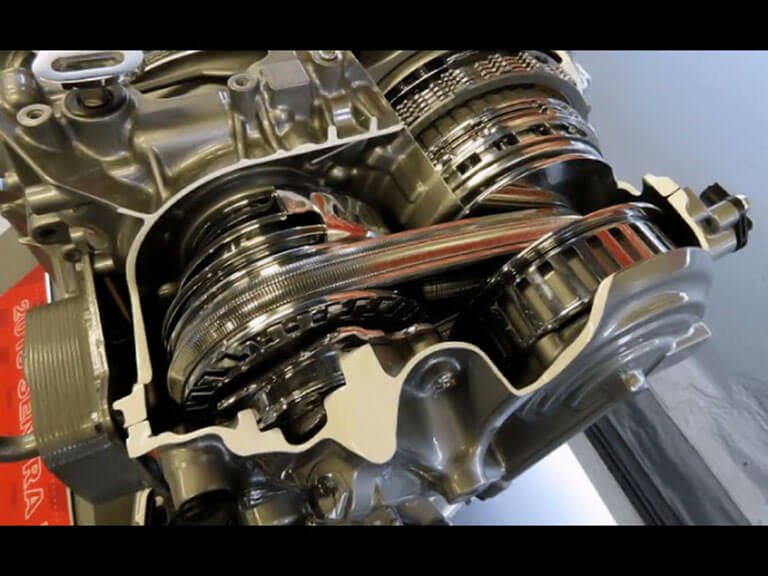Toyota CVT Transmission Problems: Quick Fixes & Tips
Toyota CVT transmission problems often stem from overheating, fluid issues, or software glitches. These issues can lead to poor performance and costly repairs.
The continuously variable transmission (CVT) in Toyota vehicles offers smooth acceleration and improved fuel efficiency. Despite these advantages, some drivers have reported various issues that can affect performance and reliability. Problems like slipping, hesitation during acceleration, and unusual noises can frustrate owners.
Regular maintenance and timely fluid changes can help mitigate many of these issues. Understanding the common signs of CVT problems allows drivers to address concerns early. This proactive approach can save money on repairs and enhance the driving experience. Proper care and attention are essential for keeping your Toyota’s CVT running smoothly.
Introduction To Toyota’s Cvt

Toyota has embraced the Continuously Variable Transmission (CVT) in many of its vehicles. This technology aims to enhance fuel efficiency and provide a smoother driving experience. Understanding how CVT works in Toyota cars is essential for potential buyers and current owners.
The Rise Of Cvt In Toyota Vehicles
CVT technology gained popularity in the automotive industry. Many car manufacturers now use it. Toyota introduced CVT in several models, including:
- Toyota Prius
- Toyota Corolla
- Toyota Camry
- Toyota RAV4
These vehicles feature CVT for better performance. The rise of CVT in Toyota shows their commitment to innovation.
Benefits Of Using Cvt
CVT offers various benefits for drivers. Here are some key advantages:
- Improved Fuel Efficiency: CVT optimizes engine performance, saving fuel.
- Smoother Acceleration: The absence of gear shifts leads to seamless power delivery.
- Lightweight Design: CVTs are generally lighter than traditional transmissions, improving overall vehicle weight.
- Better Performance in Stop-and-Go Traffic: CVTs excel in city driving, enhancing driver comfort.
These benefits make CVT a popular choice among Toyota drivers.
Common Issues With Toyota Cvt
Toyota’s Continuously Variable Transmission (CVT) offers smooth driving. Yet, some drivers face problems. Recognizing common issues helps in timely repairs. Here are key problems with Toyota CVT.
Jerky Movements And Slippage
Drivers often report jerky movements while driving. This can feel like sudden jolts during acceleration. It may indicate slippage in the transmission.
- Common causes include low transmission fluid.
- Worn-out CVT belts can also cause slippage.
- Software issues in the transmission control module may contribute.
Regular maintenance and fluid checks can reduce these problems.
Unusual Noises During Acceleration
Another frequent issue is unusual noises during acceleration. Drivers may hear grinding or whining sounds. These noises can signal serious transmission trouble.
- Low fluid levels may lead to these sounds.
- Worn-out bearings or gears can also create noise.
Listening to your vehicle is crucial. Early detection can save costly repairs.
Delayed Acceleration
Delayed acceleration is another common problem. Drivers may experience a lag when pressing the gas pedal. This can lead to unsafe driving conditions.
- Contaminated transmission fluid can cause delays.
- Faulty sensors may also be responsible.
Regular inspections can help identify and fix these issues quickly.
Diagnosing Cvt Problems
Diagnosing CVT problems can save you time and money. Early detection helps avoid costly repairs. Understanding the warning signs is crucial. Using the right tools and techniques makes diagnosis easier.
Warning Signs And Symptoms
Look for these common warning signs of CVT issues:
- Slipping Gears: Engine revs but the car doesn’t accelerate.
- Strange Noises: Grinding, whining, or clunking sounds.
- Unusual Vibrations: Excessive shaking while driving.
- Overheating: Warning light for high transmission temperature.
- Fluid Leaks: Puddles of reddish fluid under the car.
Tools And Techniques For Diagnosis
Use these tools and techniques for accurate diagnosis:
| Tool/Technique | Purpose |
|---|---|
| OBD-II Scanner | Reads trouble codes from the vehicle. |
| Fluid Level Check | Ensures proper transmission fluid levels. |
| Visual Inspection | Checks for fluid leaks or damage. |
| Test Drive | Identifies performance issues during driving. |
Follow these steps for effective diagnosis:
- Check for warning lights on the dashboard.
- Use an OBD-II scanner to read error codes.
- Inspect the transmission fluid color and level.
- Take the vehicle for a test drive to monitor performance.
Knowing these symptoms and tools helps in quick diagnosis. Don’t ignore any warning signs. Address problems early for better vehicle performance.
Quick Fixes For Immediate Relief
Experiencing issues with your Toyota CVT transmission can be stressful. Quick fixes provide immediate relief until a professional can help. Here are some temporary solutions to help you get back on the road.
Temporary Solutions On The Go
Here are some quick fixes you can try:
- Check the Fluid Level: Low fluid can cause problems. Make sure the transmission fluid is at the right level.
- Fluid Change: Old fluid can lead to issues. Consider changing the fluid if it looks dirty.
- Disconnect the Battery: Resetting the system may help. Disconnect the battery for about 10 minutes.
- Inspect for Leaks: Look for leaks under your vehicle. A leak can indicate a serious problem.
- Use a Transmission Additive: Some additives can improve performance. Choose one that is compatible with CVT.
When To Use Quick Fixes
Use these quick fixes in specific situations:
- When you notice strange noises.
- If the vehicle hesitates during acceleration.
- When the check engine light comes on.
- During long trips where immediate help is not available.
- If you experience slipping or jerking during shifts.
Remember, these fixes offer temporary relief. Schedule a visit to a mechanic for a thorough inspection.
Maintenance Tips To Avoid Cvt Issues
Maintaining your Toyota’s CVT is crucial. Proper care can prevent many common problems. Follow these tips to keep your CVT running smoothly.
Regular Cvt Fluid Checks
Check the CVT fluid regularly. This fluid keeps the transmission cool and lubricated. Here’s how to ensure your CVT fluid is in top condition:
- Check fluid levels monthly.
- Look for any discoloration.
- Watch for strange smells.
Follow these steps for checking fluid:
- Park the vehicle on a level surface.
- Turn on the engine and let it warm up.
- Locate the dipstick and remove it.
- Wipe it clean and insert it back.
- Check the fluid level on the dipstick.
Change the CVT fluid as recommended in your owner’s manual. Fresh fluid can prevent wear and tear.
Adopting Good Driving Habits
Your driving habits impact the CVT’s health. Here are some tips to help:
- Avoid rapid acceleration.
- Use gentle braking.
- Don’t overload the vehicle.
Follow these good driving practices:
- Start driving slowly.
- Maintain steady speeds.
- Use cruise control on highways.
Good driving can extend the life of your CVT. Stay aware of any unusual sounds while driving. Address issues promptly.
Professional Repair Vs. Diy
Many Toyota owners face CVT transmission issues. Deciding between professional repair and DIY can be tough. Understanding the problem’s complexity helps make the right choice.
Assessing The Complexity Of The Problem
Not all CVT transmission problems are the same. Some issues are simple, while others can be complex.
- Simple Issues:
- Fluid changes
- Worn-out filters
- Complex Issues:
- Internal damage
- Electronic control problems
Use these questions to assess your situation:
- Do you have basic mechanical skills?
- Do you have the right tools?
- Can you diagnose the issue correctly?
When To Seek Professional Help
Some problems require expert attention. Seek professional help in these situations:
| Signs You Need Help | Why Professional Help? |
|---|---|
| Strange noises | Internal damage may exist. |
| Slipping gears | Could indicate serious issues. |
| Warning lights | Electronic systems may fail. |
| Poor acceleration | Needs diagnostic tools. |
Professional mechanics have training and experience. They can quickly diagnose and fix problems. This saves time and prevents further damage.
Upgrading Your Cvt System
Upgrading your Toyota’s CVT system can enhance performance and reliability. Many owners face CVT problems. Upgrading can offer solutions and improve driving experience. Several options exist for those considering an upgrade.
Aftermarket Options
Several aftermarket options are available for upgrading your CVT system:
- Performance CVT Kits: These kits often include upgraded parts. They can improve power transfer and efficiency.
- Custom Transmissions: Some companies offer custom-built transmissions. These can be tailored to your specific needs.
- Fluid Upgrades: Using high-quality transmission fluid can enhance performance. Specialized fluids reduce wear and improve shifting.
- Tuning Software: Modifying the vehicle’s ECU can optimize CVT performance. This can lead to better acceleration and fuel economy.
Cost-benefit Analysis Of Upgrading
Understanding the costs and benefits of upgrading is crucial. Here’s a simple breakdown:
| Option | Estimated Cost | Potential Benefits |
|---|---|---|
| Performance CVT Kits | $1,500 – $3,000 | Improved power and efficiency |
| Custom Transmissions | $3,000 – $6,000 | Tailored performance |
| Fluid Upgrades | $100 – $300 | Better shifting and reduced wear |
| Tuning Software | $500 – $1,500 | Enhanced acceleration and fuel economy |
Consider these factors before upgrading:
- Budget: Determine how much you can spend.
- Driving Style: Assess how you drive. Do you need more performance?
- Long-Term Plans: Consider how long you plan to keep the vehicle.
Upgrading your CVT system can offer significant advantages. Assessing your options carefully can lead to better decisions.
Long-term Solutions And Prevention
Addressing Toyota CVT transmission problems requires proactive measures. Long-term solutions focus on preventing issues before they arise. Proper care and maintenance can extend the life of your transmission.
Investing In Quality Parts
Using quality parts is crucial for your vehicle’s performance. Cheap parts may save money now, but they can lead to more problems later. Here are some key points to consider:
- Choose OEM (Original Equipment Manufacturer) parts.
- Research reputable aftermarket brands.
- Verify the warranty offered on parts.
Investing in quality parts ensures better reliability and longevity. It can prevent costly repairs down the road.
Scheduled Professional Servicing
Regular maintenance is vital for preventing CVT issues. Schedule professional servicing at recommended intervals. This helps catch problems early.
Follow these steps for effective maintenance:
- Check the transmission fluid level regularly.
- Change the fluid according to the owner’s manual.
- Inspect the CVT filter and replace it as needed.
Professional technicians can identify potential issues early. They have the tools and expertise to keep your transmission in top shape.
Conclusion: Navigating Cvt Challenges
Navigating the challenges of Toyota’s CVT transmission requires knowledge and preparation. Understanding these issues helps drivers maintain their vehicles effectively. Recognizing signs of trouble early can save time and money.
Recap Of Effective Strategies
Here are some effective strategies to tackle CVT issues:
- Regular Maintenance: Follow Toyota’s recommended service schedule.
- Fluid Checks: Inspect CVT fluid levels regularly.
- Listen for Noises: Unusual sounds may indicate a problem.
- Temperature Monitoring: Keep an eye on transmission temperature.
- Immediate Repairs: Address issues promptly to avoid further damage.
Implementing these strategies enhances the longevity of your CVT. Awareness and action can prevent major failures.
The Future Of Cvt In Toyota Vehicles
The future of CVT technology in Toyota looks promising. Innovations aim to improve performance and reliability.
| Innovation | Description |
|---|---|
| Advanced Materials | Stronger components reduce wear and tear. |
| Smart Technology | Adaptive systems enhance driving experience and efficiency. |
| Improved Cooling | Better cooling systems prevent overheating issues. |
Drivers can expect more reliable CVT experiences. Continuous improvements will likely enhance overall driving satisfaction.
Frequently Asked Questions
What Are Common Toyota Cvt Transmission Problems?
Common issues include slipping, shuddering, and delayed acceleration, often caused by low fluid levels or faulty sensors.
How To Identify Cvt Transmission Issues?
Signs include unusual noises, warning lights, and difficulty shifting gears. Early detection can prevent costly repairs.
Can Cvt Transmission Be Repaired Easily?
Repairs can vary in complexity. Simple issues may be fixed, while extensive damage often requires a full transmission replacement.
What Causes Cvt Problems In Toyota Vehicles?
Causes often include overheating, poor maintenance, or manufacturing defects. Regular service helps mitigate these risks.
How To Maintain A Toyota Cvt Transmission?
Regular fluid changes and following the manufacturer’s maintenance schedule are crucial for prolonging CVT lifespan.
Conclusion
Toyota CVT transmission issues can be frustrating for owners. Regular maintenance and prompt repairs can help extend the life of your vehicle. Staying informed about potential problems is essential. By understanding these issues, you can make better decisions for your car’s performance.
Drive safely and enjoy your Toyota experience.






